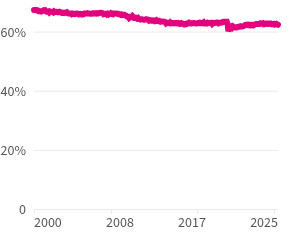What is the unemployment rate in the US right now?
About 4.4% in September 2025. That's a 0.3 percentage point increase from a year before. The unemployment rate is the percentage of people in the labor force who are actively looking for work but not currently employed. It's a common way to measure the health of the job market and economy.
4.4%
+0.3
In September 2025, the unemployment rate in the US was 4.4%.
Seasonally adjusted unemployment rate, January 2007 to September 2025

Since 1948, the unemployment rate has often increased during or after recessions.
Seasonally adjusted unemployment rate, January 1948 to September 2025
In August 2025, the unemployment rate varied across states.
Seasonally adjusted unemployment rate
Unemployment rate, by state (August 2025)
| 1. | Washington, DC | 6.0% |
| 2. | California | 5.5% |
| 3. | Nevada | 5.3% |
| 4. | Michigan | 5.2% |
| 5. | New Jersey | 5.0% |
| 6. | Ohio | 5.0% |
| 7. | Oregon | 5.0% |
| 8. | Massachusetts | 4.8% |
| 9. | Alaska | 4.7% |
| 10. | Kentucky | 4.7% |
Keep exploring
Methodology
USAFacts standardizes data, in areas such as time and demographics, to make it easier to understand and compare.
The analysis was generated with the help of AI and reviewed by USAFacts for accuracy.
Page sources
USAFacts endeavors to share the most up-to-date information available. We sourced the data on this page directly from government agencies; however, the intervals at which agencies publish updated data vary.
